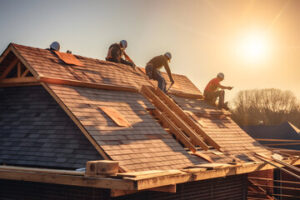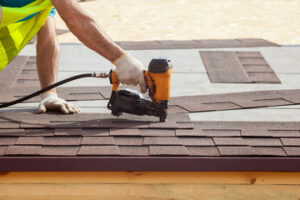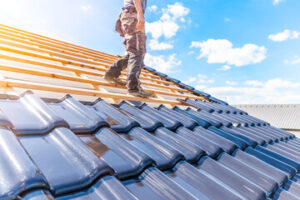A metal roof can be a great addition to any home or building. Its contemporary aesthetic and durability make it a popular choice for homeowners.
When installing a new metal roof, it’s important to follow certain guidelines to ensure your roof is durable and long-lasting. Follow these tips: Choose a Quality Underlayment. Contact Erie Metal Roofing now!

There are many reasons why metal roofing is becoming a popular choice for homeowners. It’s durable, energy-efficient, and comes in a variety of styles to suit any home’s aesthetic. It also has a long lifespan, easily outliving traditional shingle roofs and standing up to severe weather conditions.
In fact, metal roofs can withstand winds of up to 140 miles per hour without tearing or fading. They are also resistant to heavy snowfall, hail and fire. Additionally, a metal roof can help reduce energy costs by reflecting solar radiant heat.
Metal roofs are also known to resist moisture buildup and corrosion. However, it’s important to properly ventilate your attic space to minimize humidity and condensation. This will prevent the development of mold, fungus and mildew that can damage your metal roof and lead to leaks.
In addition to avoiding moisture, it’s important to regularly inspect your metal roof for signs of wear and tear. This includes assessing your panel profile and thickness, coatings and paints, as well as fasteners and seams. Regular maintenance will keep your roof in top shape and prolong its life.
If you do happen to notice a scratch or scuff on your metal roof, it’s recommended that you contact your metal roofing supplier or manufacturer right away. Most scratches can be repaired with a paint or touch-up pen designed to match the color of your roof. However, if the gouge is deep enough that it exposes the metal substrate, it may be time to replace that specific panel or part of your roof.
Aside from their durability, metal roofs are also known for increasing the resale value of your home. Potential buyers are often willing to pay a premium for homes with quality roofing materials, particularly those made from metal.
As an added bonus, metal roofs are available in a wide range of colors and finishes to complement any architectural style. Whether you prefer a rich earth tone or a sleek silver finish, a metal roof can make your home stand out from the rest. Just be sure to choose a durable paint system that protects against rust, fading and other forms of color degradation.
It’s Energy-Efficient
Metal roofs protect homes from extreme weather conditions such as heavy rain, snow, and hail. They also reflect sunlight, helping to lower cooling costs during summer months. These energy savings help offset the upfront expense of a metal roof and make it an excellent investment for homeowners. In addition, unlike asphalt shingle roofs, metal roofs don’t leak and do not need to be replaced frequently.
The color of a metal roof affects its solar reflectivity and emissivity value, which directly affect energy efficiency. Lighter colors reflect sunlight and heat, keeping interiors cooler and reducing air conditioning usage. Conversely, darker roofs absorb more heat, making buildings warmer and increasing the strain on HVAC systems.
Energy prices are at an all-time high, and people are looking for ways to reduce their carbon footprints and save money on their energy bills. Changing equipment or appliances to use less energy is one way, and adding insulation is another. Fortunately, many of these measures are easy for home and business owners to implement.
Metal roofing is one of the most energy-efficient options for homes and businesses. Not only do they last twice as long as shingle roofs, but they’re also more durable and recyclable, and can qualify for LEED points and tax credits for their sustainable design and energy-saving qualities.
While metal roofs may produce more noise than shingle roofs, the sound can be minimized by using additional insulation or a heavier gauge of metal panels and selecting textured coatings. Additionally, the noise produced by rainfall can be dampened with a specialized underlayment.
It’s Affordable
As any homeowner knows, a roof is a big investment. That’s why it’s important to carefully consider your options when selecting a new roof. The initial cost is only one factor to consider, though. Durability, maintenance requirements, energy efficiency and your local weather conditions are also crucial.
Thankfully, affordable metal roofing is available to homeowners interested in maximizing their budgets without sacrificing quality or durability. In fact, many homeowners find that a metal roof offers greater value in the long run than other roofing materials, including traditional asphalt shingles.
There are a variety of factors that influence the price of a metal roof, so it’s essential to speak with a professional roofing contractor to get an accurate estimate. The type of metal used and the design of your roof can significantly affect the overall cost. For example, standing seam metal roofs tend to be the most expensive, while tin (or Terne) roofs are typically less costly. The size of your roof is another important factor, as larger roofs require more materials and labor to install.
The type of underlayment you choose will also impact the cost of your metal roof. Felt paper and synthetic underlayments are generally the least expensive, but they can also be problematic in extreme climates where expansion and contraction can damage metal roofing. High-heat ice and water shields are an excellent alternative to these underlayments. They are more expensive but can help ensure that your metal roof remains watertight and energy-efficient throughout its lifespan.
Another way to reduce your roofing costs is to work with a supplier that offers flexible color options. Some suppliers, such as 5280 Metal Supply, offer a range of color choices that can fit a wide range of architectural styles and budgets.
While the upfront cost of a metal roof can seem intimidating, it’s essential to remember that it’s an investment in your home’s durability and longevity. In addition, you can save on energy costs by choosing a roofing material that reflects the sun’s rays, helping reduce your utility bills.
Choosing a durable, cost-effective metal roof is easy when you know what to look for. With the help of a knowledgeable supplier like 5280 Metal Supply, you can make an informed decision that will improve your home’s aesthetics and withstand harsh Colorado weather conditions.
It’s Eco-Friendly
Metal roofing is an eco-friendly building material in every sense of the word. It’s durable, energy-efficient and requires minimal maintenance. Compared to shingles, it also has excellent fire resistance and is impervious to rot, pests and mould. Moreover, it can be recycled at the end of its lifespan without losing its structural integrity, meaning it has no negative impact on the environment.
A metal roof’s most prominent feature is its durability against the elements. It’s not only resistant to wind, but it can also withstand hail and snowfall. This makes it a popular choice in areas prone to wildfires, as well as hurricanes and tornadoes. In addition, the material’s corrosion resistance makes it a great fit for coastal areas.
As a highly versatile product, metal roofing is available in several different styles. It can be fashioned into the look of traditional shingle roofing, or you can opt for a more contemporary style such as standing seam construction. It can even be manufactured to resemble wood shakes, slate or clay tiles if you prefer a more natural aesthetic.
A metal roof is also energy-efficient, reducing your electricity bills by reflecting solar radiant heat. This significantly reduces the strain on air conditioning systems during the summer and saves homeowners money over time.
Its longevity, paired with its recyclability, makes metal roofing a favourite among eco-conscious builders. New panels often include up to 40% recycled steel and can be fully recycled at the end of their lifespan, which virtually eliminates their landfill impact. Asphalt shingles, on the other hand, are not recyclable and end up in landfills after their life cycle has ended.
Not only are metal roofs more environmentally friendly, but they are also easier to install for roofing professionals. This is because the material can be fabricated on-site, rather than being cut and nailed like shingles, which requires additional materials and labour. Similarly, the material can be installed over existing shingles to minimise any waste disposal costs and unnecessary demolition. This means that the process is faster and more cost-effective, allowing the roof to be installed quickly and without interrupting daily business operations.




